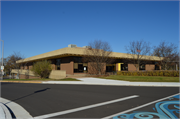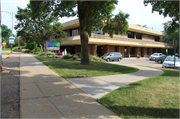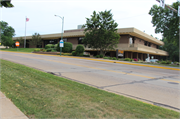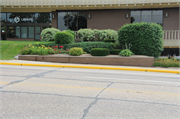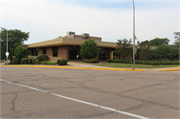Property Record
490 E GRAND AVE
Architecture and History Inventory
| Historic Name: | McMILLAN MEMORIAL LIBRARY |
|---|---|
| Other Name: | |
| Contributing: | |
| Reference Number: | 230817 |
| Location (Address): | 490 E GRAND AVE |
|---|---|
| County: | Wood |
| City: | Wisconsin Rapids |
| Township/Village: | |
| Unincorporated Community: | |
| Town: | |
| Range: | |
| Direction: | |
| Section: | |
| Quarter Section: | |
| Quarter/Quarter Section: |
| Year Built: | 1970 |
|---|---|
| Additions: | |
| Survey Date: | 20152024 |
| Historic Use: | library |
| Architectural Style: | Contemporary |
| Structural System: | |
| Wall Material: | Brick |
| Architect: | Grassold-johnson-wagner and Isley, Inc. |
| Other Buildings On Site: | |
| Demolished?: | No |
| Demolished Date: |
| National/State Register Listing Name: | Not listed |
|---|---|
| National Register Listing Date: | |
| State Register Listing Date: |
| Additional Information: | A 'site file' exists for this property. It contains additional information such as correspondence, newspaper clippings, or historical information. It is a public record and may be viewed in person at the Wisconsin Historical Society, State Historic Preservation Office. 2015-Constructed in 1970, the McMillan Memorial Library and associated parking lot encompass an entire city block, which features mature trees, manicured grass lawn, decorative landscaping, library sign, and a memorial water foundation (1). The library fronts Lincoln Street and is accessed by a concrete walkway that leads to paired plate-glass entrance doors with a fixed light transom centered on the front (southeast) facade. The building was built into the side of a small hill, creating an exposed basement level on the rear (northwest) elevation with access to the library directly from the parking lot. This two-story building has a rectangular plan and is clad in brick veneer. As a whole, it features decorative details that are reminiscent of Contemporary architecture, such as a flat roof with massive overhanging eaves that display a simple rectangular pattern repeated along the face of the eaves, dentils, and checkerboard pattern on the underside. A simple concrete balustrade with a similar checkerboard pattern on the underside wraps around portions of the building, providing a buffer between the sidewalk access and landscaping. Large plate-glass windows grouped in threes are found on each elevation, including the basement level. The entryway on the rear, basement level of the library was reconfigured in 2010 to include electronic sliding doors. A plaque located near the entryway states “New Entrance made possible by a gift from Charles & JoAnn Lester, June 2010.” The interior of the library appears to retain its original configuration with open spaces with shelving for books along with meeting/conference rooms. 2017- "The McMillan Memorial Library is located at 490 E. Grand Avenue in Wisconsin Rapids. The property occupies a city block bounded by E. Grand Avenue, Lincoln Street, Birch Street, and Garfield Street. The library is sited on the southeastern half of the parcel with its front (northeast) facade facing E. Grand Avenue. An associated parking lot occupies the northwest portion of the block, accessed via driveways on Garfield Street. The library is built into a slope, and the main (upper) level is at-grade on the front facade and southeast (side) elevation. A concrete walkway on the front facade and southeast (side) elevation continues as a cantilevered balcony as the ground slopes away to expose the lower level on the northwest (side) and southwest (rear) elevations. A concrete sidewalk separates the property from the adjacent roadway on all sides, and a grassy lawn behind the sidewalk surrounds the library on the northeast, southeast, and southwest sides. The landscaped lawn incorporates mature trees and ornamental plantings, and raised beds bordered by a brick retaining wall are adjacent to the front facade. The northeast lawn also includes a flagpole, sign, and fountain. A metal fence encloses the Youth Courtyard on the southeast elevation and a concrete walkway provides access to the south corner of the building. Built in 1970, the McMillan Memorial Library was designed by the Milwaukee firm Grassold-Johnson Wagner & Isley, Inc. and displays Brutalist influences in its broad, overhanging flat roof, cantilevered concrete walkway surrounding the building, sloped site, and restrained use of vertical elements such as narrow windows, flat brick pilasters, and patterned concrete. The building is clad in brick veneer and rests on a concrete slab foundation partially below grade. The slab-like roof overhang features a pattern of narrow recessed panels in the concrete fascia, echoed in the negative space created by the concrete balustrade that surrounds the cantilevered portion of the walkway. The flat roof features a large central skylight and a small, raised, brick penthouse contains HVAC and mechanical equipment. The undersides of the roof overhang and walkway both feature a cellular pattern of recessed squares that form a grid when viewed from below and suggest dentils when seen in elevation. The exposed portions of the lower level feature solid brick walls punctuated by regularly spaced brick pilasters, while the upper level displays a smooth wall plane. Fenestration generally consists of narrow, single-pane, full-height windows, found in groups of three on the upper level and singly on the lower level. The northeast (front) facade facing E. Grand Avenue features a large, off-center entry. This entrance contains two sets of metal double doors separated by two fixed panes, with a series of transoms above. Originally designed as the primary entrance, it was reconfigured as an emergency exit in 2010 when a new basement-level entrance on the northwest elevation (known as the Lester Entrance) was put into use. The stairs from the street to the E. Grand Avenue entrance were removed between 2008 and 2010 and replaced with grass. The main story facade features five groupings of windows: two are located to the east of the entry and three to the west. The walkway balustrade begins at the E. Grand Avenue entry and continues west to wrap around the west and rear (south) elevations. The exposed basement level is visible at the west end of the facade, and square brick pillars support the portion of the walkway above a deeply recessed secondary entrance located at the north corner of the lower level. A modern illuminated sign and fountain are located at the north corner of the building. The current primary entrance (known as the Lester Entrance), is located on the lower level of the northwest (side) elevation of the building, accessible from the parking lot and Garfield Street. The offcenter entrance features double, aluminum-frame, sliding glass doors with transom windows above, and tall, narrow windows are irregularly spaced across the elevation. A single garage door is located at the west corner. The upper level features four window groupings; two are located above the entrance, while the others are located near each corner. The upper level is at-grade along the entire southeast (side) elevation facing Lincoln Street. A central entrance consists of a single metal door flanked by single-pane sidelights in metal frames with a threelight transom. A group of windows are located immediately to the south of the entrance, and other groupings are located near each corner. A metal fence and plantings surround the entrance to form a courtyard. This courtyard, created in 2013 as the WoodTrust/Bell Foundation Garden, is an exterior extension of the Youth Services Room, and is only accessible from the interior of the building. The lower level is partially exposed along the rear (southwest) elevation facing Birch Street. The concrete balustrade begins at the south corner of the building and spans the elevation. The upper level features six window groupings, while the lower level is unfenestrated where exposed. A utility area surrounded by chain-link fencing is located at the center of the elevation. Interior The interior of the library is open to the public and was accessed in July 2017. The cellular grid concrete pattern found on the underside of the roof slab is continued into the building's interior at the former main entrance on E. Grand Avenue. Beyond a shallow glass enclosed vestibule, stairs and an elevator lead from the upper level to the lower level. The main stairway consists of two flights of steps with a central landing. The metal balustrade has rectangular balusters and the stairwell's walls are covered in small tiles. The upper level has a carpeted floor, drop ceiling with fluorescent light fixtures, exposed brick exterior walls, and drywalled interior support posts and non-load-bearing walls. It consists of a single large open area that contains the Adult Room, the Young Adult Area, and the Children/Youth Services Room, separated by librarian desks and a self-checkout area. The library office is located behind the librarians' desks. The Adult Room, on the west side of the main floor, is a large open space for adult services, containing tables, computer stations, a reading area with individual chairs set under the large skylight, and wooden bookshelves. The skylight itself contains a grid pattern of fluorescent lights, echoing the concrete grid found on the underside of the roof, walkway, and the ceiling above the main entryway. The Children/Youth Services Room, on the east side of the main floor provides access to the exterior WoodTrusUBell Foundation Garden on the southeast side of the building. The main floor also includes the McCourt Conference Room and bathrooms. The lower level is generally divided in half: the western portion is largely undivided, and includes an open shelving area and cafe ("Commons") and sorting room, while the eastern half is subdivided into several enclosed spaces that include the Fine Arts Center auditorium. Much of the lower level has linoleum floors, while the area around the stairwell is carpeted. Although portions of the lower level have drop ceilings, the concrete cellular grid is visible in much of the western half. The exterior walls are concrete block and are generally exposed throughout the lower level. Accessed via the Lester Entrance and vestibule, the Commons was renovated to its current configuration in 2006 and includes wooden bookshelves, a reading area, coffee shop, computer terminals along the wall, and a self-checkout space. The Fine Arts Center auditorium includes a large stage and retains its original metal and wood auditorium seats. The backstage area includes separate dressing rooms. Integrity The library retains its original cladding, doors, windows, and Brutalist-influenced features, including the patterned concrete roof and exterior walkway. Though a new entrance has been added at the basement level, the original entrances facing E. Grand Avenue remain. Despite the change in orientation, the elimination of the front walkway to the original main entrance is the only alteration to the setting. The interior also retains good integrity. The floorplan of the main floor, meeting rooms, and auditorium are generally unchanged and retain some historic finishes. Although the Commons and coffeehouse have been introduced, the basement level retains its original floorplan with shelving area and community rooms, including the auditorium. Overall, the building conveys integrity as a Modern library with Brutalist influences. E. Grand Avenue Wisconsin Rapids developed from what were two separate communities on either side of the Wisconsin River: Grand Rapids (east bank) and Centralia (west bank). Important local industries included lumber, paper, and pulp production; agriculture, especially dairy and cranberries; and manufacturing and commercial enterprises such as furniture making, breweries, bakeries, grocery, and drug stores. Four separate rail lines served the growing cities and development centered along the banks of the river. 4 E. Grand Avenue at the southern periphery of the Grand Rapids commercial core experienced both commercial and residential development, as evidenced by the construction of the Wood Block (AHI No. 16741, 132 E. Grand Avenue) and former post office and Elk's Club (AHI No. 16738, 110 E. Grand Avenue). Grand Rapids and Centralia unified in 1900 under the name of Grand Rapids, which officially changed to Wisconsin Rapids in 1920. In the following decade Mayor G.W. Mead's park beautification program along with other civic improvements led to the demolition of several commercial buildings, including some fronting E. Grand Avenue, to establish a park along the east bank of the Wisconsin River. A 1919 Sanborn map shows development extending along E. Grand Avenue (then Vine Street) four blocks east of the river; commercial and civic buildings including a post office, bank, and movie theater clustered toward the west side of the corridor while residential development stretched east. 6 As of 1922 a new, 500-foot concrete arch bridge (AHI No. 16734, nonextant) was completed along E. Grand Avenue over the Wisconsin River, replacing an older truss bridge and solidifying the roadway's function as a major transportation route connecting the two sides of the unified city. The residents of Wisconsin Rapids struggled during the financial hardship of the Great Depression. However, with the guidance of Mayor Mead, the city pulled together to provide support for citizens hit hardest by the economic decline. Beginning in the 1920s and lasting through the Great Depression, many of the early frame structures along E. Grand Avenue were replaced with new buildings, such as the post office (AHI No. 16745, 320 E. Grand Avenue) and Episcopal Church of St. John the Evangelist (AHI No. 16742, 320 Oak Street). The community began to experience an economic boom not long after the United States entered World War II. Local factories fabricated items ranging from aircraft materials to army coats in an effort to support the war. By the postwar era the local economy had strengthened. Combined with the number of returning war veterans, the thriving economy led to a substantial population increase from 11,416 in 1940 to 13,496 in 1950 and, in turn, a need for new buildings. Wisconsin Rapids continued to prosper throughout the 1950s. The Modernist Wood County Courthouse (outside the APE) was completed north of E. Grand Avenue in time for the county centennial in 1956. Construction of new schools and shopping areas followed. As automobiles became more integrated into daily life, local businesses and residential development responded. For example, the Dairy Queen (AHI No. 76431, 551 E. Grand Avenue) had a large parking lot to accommodate drive-up traffic. As area telecommunications improved, the Wood County Telephone Company constructed a new building to accommodate dial service technology in 1958 (AHI No. 160761, 440 E. Grand Avenue). The area's population grew in tandem with physical expansion and the total number of residents reached 18,587 by 1970. That number began to decline in the 1980s as people relocated to outlying areas but has overall remained steady since then. Property History The McMillan Memorial Library is the fourth in a series of library facilities that have served the public of Wisconsin Rapids. The first three were located in buildings that were not designed for library use and were limited in space. By the early 1960s the library's Board of Trustees realized that a new library would have to be built. Though former Wisconsin Rapids resident Mary McMillan Burt had planned a bequest for the building of a new library, the Board felt a new library could not wait. Mrs. Burt was approached to release the funds into trust for the building of a new library instead of leaving them to the city in her will. These funds, combined with a federal grant, city funds, and other gifts, allowed for the building of a new library. The new building was the first purpose-built library constructed in Wisconsin Rapids. With funding for the new library procured, the head librarian and the Building Committee prepared a plan for the new library system. They utilized a community study for southern Wood County, published in 1965, to estimate needs for the library in size and types of population, and in the specific library operations that would be necessary to serve a growing and diverse community through the 1980s. The community study influenced building design details such as the size of the adult reading rooms and facilities for young adults, as well as the inclusion of a garage space for a vehicle for a book van service. By 1966 the Milwaukee-based architectural firm of Grassold-Johnson-Wagner & Isley Inc. was chosen to design the new building. The ground-breaking ceremony for the new library occurred on June 20, 1968. Hagman Construction Co. of Minneapolis served as general contractor. Chicago landscape architect Franz Lipp designed the extensive plantings that surrounded the building, many of which appear to remain. The McMillan Public Library, named in honor of the parents of benefactor Mary McMillan Burt, opened May 17, 1970. The design of the new library included specific spaces for meetings of community groups and a Fine Arts Center for movies, theater events, concerts, and lectures, in addition to more room for the library collections. Reflecting the contemporary fears of a nuclear attack by the Soviet Union, the entire lower level, aside from the staff room, was constructed to Civil Defense specifications to serve as a fallout shelter for up to 1,800 people. The library continued to serve as both a community and school library until the 1979 construction of a new high school, and featured the new amenity of a book-van service for the elderly, shut-ins, and those individuals in the county jail. County library service continued to expand as well, with Wood County accepting responsibility for the countywide library service as Wisconsin's Public Library Access Law was passed in the early 1970s. 16 In 1979 it was honored as the Library of the Year by the Wisconsin Library Association." -"McMillan Memorial Library", WisDOT#6999-07-19, Prepared by Mead & Hunt, Inc. (Sebastian Renfield), (2017). |
|---|---|
| Bibliographic References: | (1) - Alice McCaul Hayward, Centennial Story, 1890-1990: McMillian Memorial Library, Wisconsin Rapids (Wisconsin Rapids: Wis., McMillian Library Press, 1990), 32. |
| Wisconsin Architecture and History Inventory, State Historic Preservation Office, Wisconsin Historical Society, Madison, Wisconsin |

